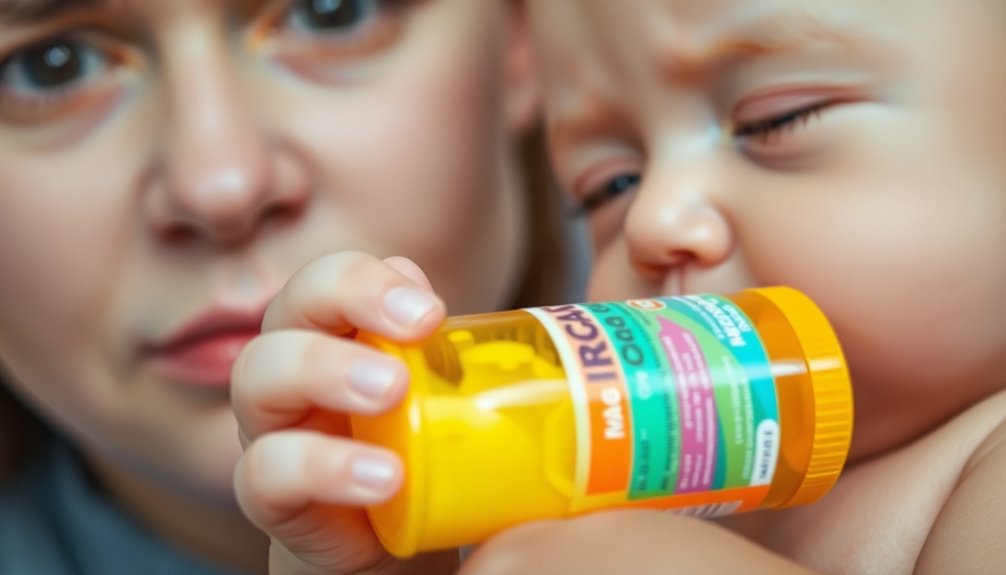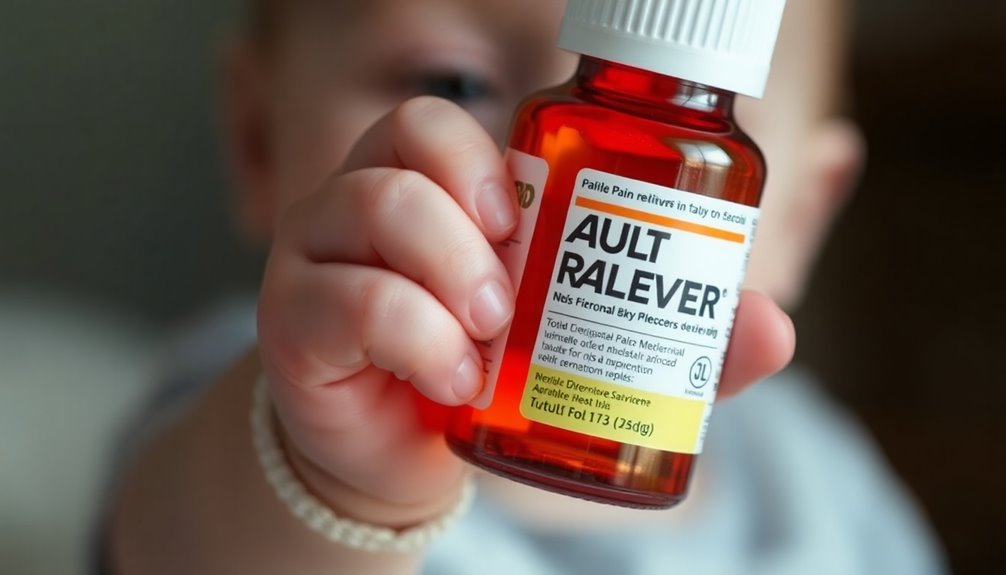The use of pain relievers in babies can be shocking and risky if not managed correctly. You need to pay attention to their non-verbal pain signals and only administer appropriate medications like paracetamol or ibuprofen, based on their age and weight. Always consult a pediatrician first to avoid potential overdoses. Additionally, adult medications are dangerous for infants if dosed incorrectly. Want to know more about ensuring your baby's safety and comfort during pain relief?
Key Takeaways
- Infant pain relief should only be administered after consulting a pediatrician to ensure safety and appropriate medication choice.
- Paracetamol is safe for infants from one month, while ibuprofen can be given from three months of age.
- Always calculate dosages based on the infant's age and weight, using proper measuring devices for accuracy.
- Be aware of overdose symptoms, such as abdominal pain or nausea, and seek immediate help if suspected.
- Adult medications are dangerous for infants; always verify age-appropriate treatments and avoid expired medications.
Understanding Infant Pain Signals

Understanding when your baby is in pain can be challenging since they can't express it verbally. You'll need to rely on non-verbal cues to determine if your child is suffering.
Look for signs like crying, whimpering, or difficulty settling down. Physical indicators can include clenched fists, limbs drawn close to the chest, or even changes in skin color—like paleness or flushing. Sweating may also signal discomfort.
Pay attention to agitation, fidgeting, and disrupted sleep patterns, as these can indicate your baby is in pain. Unusual behaviors, like persistent crying or altered feeding habits, should prompt you to seek medical advice.
Being aware of these pain signals is essential for ensuring your child's well-being, especially during minor medical procedures.
The Importance of Pain Management in Infants

Recognizing your baby's pain signals is just the first step in guaranteeing their comfort and wellbeing. Infants can't communicate their discomfort, so it's essential to look for cues like crying or agitation.
Pain management is important, especially during medical procedures such as vaccinations, which, while causing minor pain, are critical for long-term health. To provide effective pain relief, consider soothing techniques like swaddling or breastfeeding.
Effective pain management during vaccinations is vital; soothing techniques like swaddling and breastfeeding can provide comfort and support.
For medication, paracetamol can be given from one month, and ibuprofen from three months, but always verify you use the correct dosage based on your baby's weight.
If your little one experiences moderate to severe pain, consult a healthcare professional promptly to address the underlying cause and make sure your baby feels better quickly.
Safe Practices for Administering Pain Relief

When it comes to administering pain relief for your baby, safety should always be your top priority.
First, consult a pediatrician before giving any child medicine, especially for infants under 3 months old. For babies 1 month and older, paracetamol is an option, while ibuprofen can be used from 3 months.
Always verify you're using the correct dose based on your baby's age and weight, adhering to maximum dosage limits. Use the measuring device provided with the medication—never kitchen spoons—to avoid accidental overdoses.
Be cautious of combining products containing acetaminophen, as this can lead to cumulative overdose.
Monitor your baby for signs of overdose, like abdominal pain or nausea, and seek help immediately if you suspect any issues.
Common Pain Medications for Babies

When your baby's in pain, knowing the right medications can make all the difference.
You can safely use paracetamol from one month old and ibuprofen from three months, but it's essential to follow safe dosage guidelines based on their age and weight.
Always check with your healthcare provider if you're unsure about what's best for your little one.
Safe Dosage Guidelines
Administering pain relievers to babies requires careful attention to dosage guidelines to guarantee their safety.
Paracetamol is safe for babies starting at 1 month, while ibuprofen is suitable from 3 months. Always base dosages on your child's age and weight, sticking to a maximum of 5 doses in 24 hours for paracetamol.
Use the measuring device that comes with the medication to ascertain accurate dosing; avoid kitchen spoons to prevent mistakes.
Never give aspirin to babies unless a doctor directs you, due to the risk of Reye's syndrome.
Always consult your child's pediatrician before giving any medication to infants under 3 months old, as this helps ascertain the right treatment and safety for your little one.
Effective Pain Relief Options
Choosing the right pain relief option for your baby can be essential, especially when they're uncomfortable due to pain or fever.
Paracetamol is safe for babies starting at 1 month old, while ibuprofen can be given from 3 months. Always calculate the dosage based on your child's age and weight, ensuring you don't exceed five doses in 24 hours for paracetamol.
Avoid aspirin unless a doctor recommends it, due to the risk of Reye's syndrome. Use the measuring device that comes with the medication for accurate dosing—household spoons can lead to overdoses.
Keep an eye out for common side effects, like gastrointestinal upset or allergic reactions, and monitor your baby closely after administering any pain relief.
Recognizing the Signs of Overdose

Recognizing the signs of an acetaminophen overdose in babies is essential for ensuring their safety. Quick action can make all the difference.
Here are key symptoms to watch for:
- Abdominal pain and upset stomach – If your baby seems uncomfortable or refuses to eat.
- Nausea and vomiting – Frequent vomiting can indicate a serious issue.
- Jaundice – Yellowing of the skin or eyes signals a critical situation.
Always follow the recommended dosage to relieve pain effectively and avoid accidental overdoses, especially in children under five.
If you suspect an overdose, contact the Drug and Poison Information Center at 1-800-222-1222 for immediate assistance. Your awareness can help keep your little one safe!
The Impact of the 'Tripledemic' on Medication Availability

With the 'tripledemic' causing a surge in respiratory illnesses, you're likely noticing an increase in demand for children's fever-reducing medications.
This spike has led to significant challenges in finding products like Children's Tylenol and Motrin, especially in regions like western New York.
As parents panic buy and stockpile, it's essential to stay calm and check various stores for availability.
Increased Demand for Medications
As respiratory viruses surged during the recent 'tripledemic,' parents found themselves facing an unprecedented increase in demand for children's fever-reducing medications.
This spike in pediatric pain relief products like Children's Tylenol, Motrin, and Advil has led to notable shortages.
To help prevent further complications, consider these tips:
- Use existing supplies: Check your medicine cabinet before purchasing more.
- Consult healthcare professionals: Get advice on the best options for your child.
- Avoid panic buying: Rational consumer behavior can ease the strain on availability.
With fever reducer sales skyrocketing, especially in regions like Buffalo-Rochester, staying informed and prepared is essential to navigate these challenging times effectively.
Regional Supply Challenges
While the 'tripledemic' has strained medication supplies, regional differences in demand have created unique challenges for parents trying to find children's fever reducers.
In areas like Buffalo-Rochester, the demand soared by 53% in October, complicating your search for cold and flu medications. Although Johnson & Johnson insists there's no nationwide shortage, local sales of pediatric analgesics rose over 26% year-on-year, leading to panic buying.
To navigate these challenges, stay calm, check various stores, and consider online options for fever reducers in the appropriate dosage.
Additionally, engaging in community support initiatives, like medication exchanges, can help bridge the gap and guarantee your child gets the relief they need during these trying times.
Expert Recommendations for Fever Treatment

When your baby has a fever, it's essential to know how to approach treatment effectively. The American Academy of Pediatrics (AAP) advises that fever medications, like ibuprofen and acetaminophen, mainly provide comfort rather than shorten illness duration.
When treating a baby's fever, prioritize comfort over medication; consult with a healthcare provider for guidance.
Here are some expert recommendations:
- Assess Comfort: Only administer fever reducers if your baby shows discomfort; active kids may not need medication.
- Consult Professionals: Always check with your healthcare provider for personalized advice on dosage and when to use medication.
- Explore Alternatives: Keep your baby hydrated and dress them lightly to help manage fever without medication.
The Risks of Using Adult Medications for Children

Using fever reducers can provide comfort for your baby, but it's vital to confirm that the medications used are appropriate for their age and size.
Adult medications, like acetaminophen and ibuprofen, can be toxic if dosages are incorrect. Always consult a doctor or pharmacist before administering any medication.
Remember, proper dosing is based on your child's weight, so following guidelines is fundamental to avoid severe health implications.
The American Academy of Pediatrics warns against giving aspirin unless directed by a doctor due to the risk of Reye's syndrome.
Also, avoid common mistakes like using kitchen spoons for dosing and verify medications haven't expired.
For any concerns, reach out to your local Childrens Hospital for guidance.
Community Support and Resources for Parents

As parents navigate the complexities of finding safe pain relievers for their babies, community support can be an essential lifeline.
Here are three ways you can engage with your community:
- Medication Exchanges: Join local groups to share fever-reducing medications during shortages. This can guarantee you have what you need when you need it.
- Health Resources: Connect with local health organizations for guidance on safe dosing practices and to help you determine the right dosage to give your child.
- Open Communication: Talk to other parents about your needs and collaborate to prevent panic buying and stockpiling.
Community solidarity is important. Supporting each other can make a significant difference in finding necessary medications for your little ones.
Frequently Asked Questions
When Did Doctors Realize Babies Could Feel Pain?
Doctors began realizing that babies could feel pain in the late 20th century.
Research from the 1950s challenged the belief that infants were insensate, showing that pain sensitivity increases with age.
By the 1960s and 1970s, numerous studies underscored the importance of managing pain in infants.
This shift marked a significant change in medical practice, moving from a mechanistic view of infants to recognizing their physiological responses to pain.
What Happens if I Accidentally Gave My Baby Too Much Tylenol?
If you accidentally gave your baby too much Tylenol, it's like opening a can of worms! You need to act fast.
Symptoms like abdominal pain, nausea, or vomiting might show up. Always weigh your child for accurate dosing and use the measuring device.
If you suspect an overdose, don't hesitate—call the Drug and Poison Information Center at 1-800-222-1222 immediately. Your quick action can prevent serious health issues!
Can You Give an Infant Pain Reliever?
Yes, you can give an infant pain reliever, but it's important to choose the right one and use it safely.
Acetaminophen is safe for babies from 1 month old, while ibuprofen can be used from 3 months. Always measure the dose according to your baby's age and weight, using the dosing device provided.
Avoid giving aspirin unless a doctor prescribes it, as it can cause serious side effects. Always consult your healthcare provider for guidance.
What May Be the Effects of Pain Relief to the Baby?
When you give your baby pain relievers, you might wonder what could happen next.
While these medications can provide much-needed comfort, they don't cure the underlying illness. You need to be cautious, as improper dosing can lead to severe complications like liver failure.
Even rare side effects, such as nausea or allergic reactions, require careful monitoring. Always consult a healthcare professional to guarantee you're making the safest choice for your little one's wellbeing.
Conclusion
In the delicate dance of parenting, pain management for your little one is paramount. By staying savvy and safe, you can soothe their suffering without sacrificing their health. Always opt for age-appropriate approaches, ensuring your baby's wellbeing is your top priority. From fever-fighting formulas to friendly resources, you're not alone in this journey. With careful consideration and community support, you can navigate these challenges and provide your precious child with the comfort they deserve.









